A scheduled group Brecks Tour today. The overnight rain took slightly longer to clear through this morning than forecast, but once it did the rest of the day was mostly dry and even brightened up nicely around the middle of the day.
It was still drizzling lightly when we met down in the Brecks and as we drove round and pulled up by a clearing in the forest. There were no Woodlarks singing when we arrived, so we stopped to scan the paddocks opposite. A small group of Redwings was feeding down on the grass and a single bright male Brambling was in with some Chaffinches.
A Green Woodpecker was yaffling from somewhere in the trees – it was unusually vocal this morning and its calls followed us round continually all the time we were here. A pair of Marsh Tits called to each other but moved through the trees in the back of the parking area very quickly. A Treecreeper paused slightly longer, working its way up the trunks of a couple of the trees before flying off.
Once the drizzle had stopped, we set off to walk round the clearing. There was no shortage of Yellowhammers here this morning – singing, calling, perching very obligingly in the tops of the trees. But we couldn’t find any sign of the Woodlarks, either round the clearing or feeding in the field next door where they can usually be found. Given the weather, they had probably gone off to find somewhere sheltered. A Mistle Thrush was singing from the trees across the field.
We decided to try our luck in the next clearing a little further down the ride into the forest. At first, here too all we could find were more Yellowhammers but as we walked along the back of the clearing a pair of Woodlarks came in over the trees behind us. We watched as they fluttered across, short-tailed, and appeared to drop down on the edge of the ride.
When we got back round to the ride, we could see the male Woodlark perched on a tussock on the verge. We got it in the scopes and had a good look at it, before it walked quietly into the long grass. We then walked slowly down the ride to where it had disappeared and could now see the pair feeding quietly between the rows of young trees. It was a great opportunity to compare the two – the male with a brighter pale supercilium and rustier ear coverts. We could also see the distinctive way their supercilia met in a shallow ‘v’ on the back of the neck.
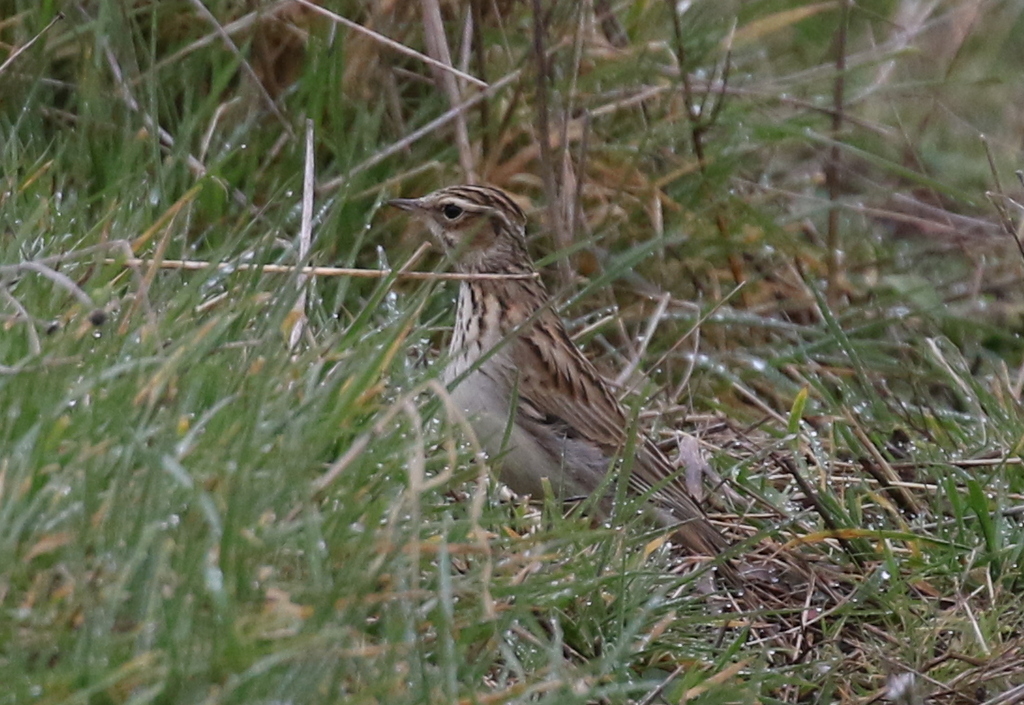
While we were watching the Woodlarks, a large flock of Redwings came low over the tops of the pines nearby. They have been on the move recently, coming back across the country ahead of making the journey back to Scandinavia for the breeding season, and these were probably migrants which were stopping off here. A Sparrowhawk shot fast and low out of the trees and across the track.
Rather like buses, there were now Woodlarks everywhere! As we walked back along the ride to the first clearing, we could now hear one singing here too. We found it perched in the top of a tree right at the back, but still through the scope we could see its bill opening and closing as it sang. Then another pair of Woodlarks flew up from the clearing and landed in a tree close to us, where we could see the female was carrying nesting material.
When the female Woodlark dropped down to the ground, the male flew to another tree right by the path, where it perched preening and singing quietly. We had fill the frame views through the scope now, with a good look at its extraordinary long hind claws.

Having finally enjoyed such great views of the Woodlarks, we decided to head straight round to try our luck with Goshawks next. It was still very grey and cloudy, with a fresh wind blowing, but at least there was a vague hint of some paler cloud to the west.
As we parked at a spot overlooking the forest, our prospects didn’t immediately look promising. There were not even any Common Buzzards up now. There were several Skylarks singing, a pair of Lapwings displaying behind us, a Curlew feeding in a recently ploughed strip and two Brown Hares in a field. A large flock of Fieldfares flew in over our heads tchacking loudly and landed in the tops of the trees behind us, where we could get the scopes on them. There were a few more Redwings in with them too – we could hear their teeezing calls as the flew over. More winter thrushes on the move.
Gradually, one or two Common Buzzards came up although they were not gaining any great height this morning. A few crumbs of encouragement perhaps. Then the clouds changed from dark grey to light grey and that was all that was needed. A male Goshawk circled up out of the trees. Its white undertail coverts were fluffed out and it started to fly with deep, exaggerated wingbeats, displaying.
That would have been good enough on its own today, but then another Goshawk appeared over the trees closer to us. Through the scopes we could see this one was browner above and more buffy-coloured below, a young bird from last year, now in its second calendar year, and it was big too, a female. It started to display as well, presumably the reason why the male had come up to remind the youngster that this was its territory. We could get both birds in the scopes displaying at one point, and then the male turned and chased after the young female, and we lost sight of both of them behind the trees.
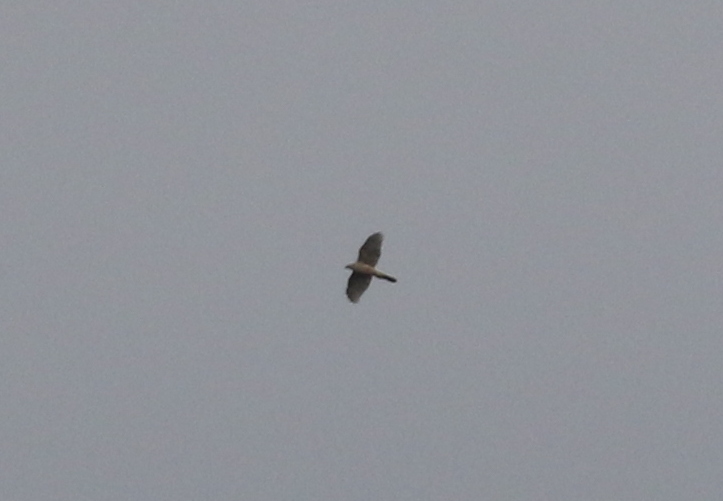
Scanning over the trees again now, we realised there was another pair of Goshawks up displaying much further over. We had gone from none to four up displaying in a matter of minutes. A distant Marsh Harrier circling up was more of a surprise to see here. Then the young female Goshawk appeared above the tops of the trees in front of us again and we turned our attention back to that. It had clearly not learnt its lesson!
Eventually, when the last Goshawk disappeared from view, we decided to move on. Someone told us there had been a couple of Stone Curlews around earlier, so we decided to go looking to see if we could find them. They are only just returning now. As we drove up the road, several Roe Deer were flushed out of the trees by a truck driving through them and scattered out across the fields beside the road. A couple of Shelduck were on the edge of a flooded dip in a field beside the road.
Unfortunately, there was no sign of the Stone Curlews now (we were warned there had been a Land Rover driving across the field earlier) and all we could find were a couple of Oystercatchers. We tried another nearby field they often favour, but there was no sign of any there either, although we did find a pair of Grey Partridge in the gateway to the field opposite. Back round the other side of the first field, another quick scan failed too. One or two Tree Sparrows were calling in the hedge here.
It was time for lunch now, so we made our way over to Brandon. With the sun now just about shining, it was nice eating out on the picnic tables, where a Nuthatch was piping in the trees. Afterwards, a quick walk down to the lake produced a couple of pairs of Mandarin Ducks, with one of them feeding out on the grass and the other on the water in the reeds. A Goldcrest was singing in the fir trees above us.
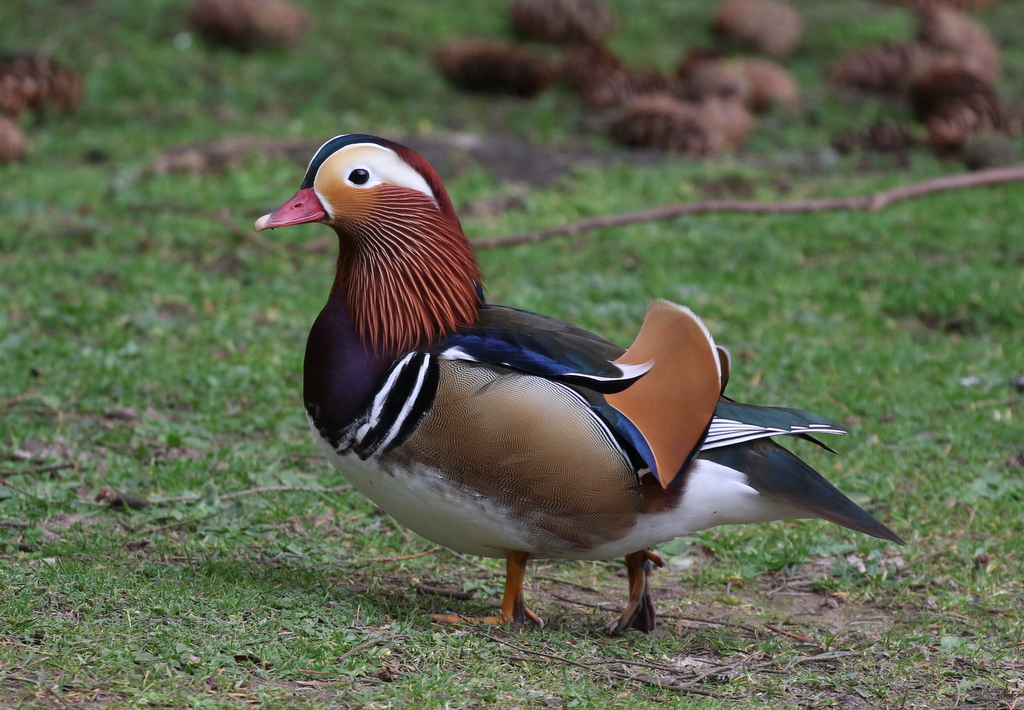
We didn’t want to run the risk of missing the Hawfinches, so we made our way straight round to Lynford Arboretum after lunch. As we walked in along the track, two people waved at us from the gate to say a Hawfinch was showing from there. When we got over, there was indeed a female Hawfinch down on the ground not very far from us. A great view!

All the birds spooked and flew up into the trees, but after a minute or so the Hawfinch dropped down again, just a little further back. We watched it hopping around, picking at the seed put down in the leaves for a couple of minutes before everything spooked again. We waited for a while, watching all the other birds coming and going, but the Hawfinch did not come back a third time.
There were plenty of other birds here though – with several Bramblings feeding down with the Chaffinches. They have been in short supply this winter, so it is always great to see some and one or two were very close again today. There were several Yellowhammers too, a Nuthatch, and a selection of tits, all coming down to feed.
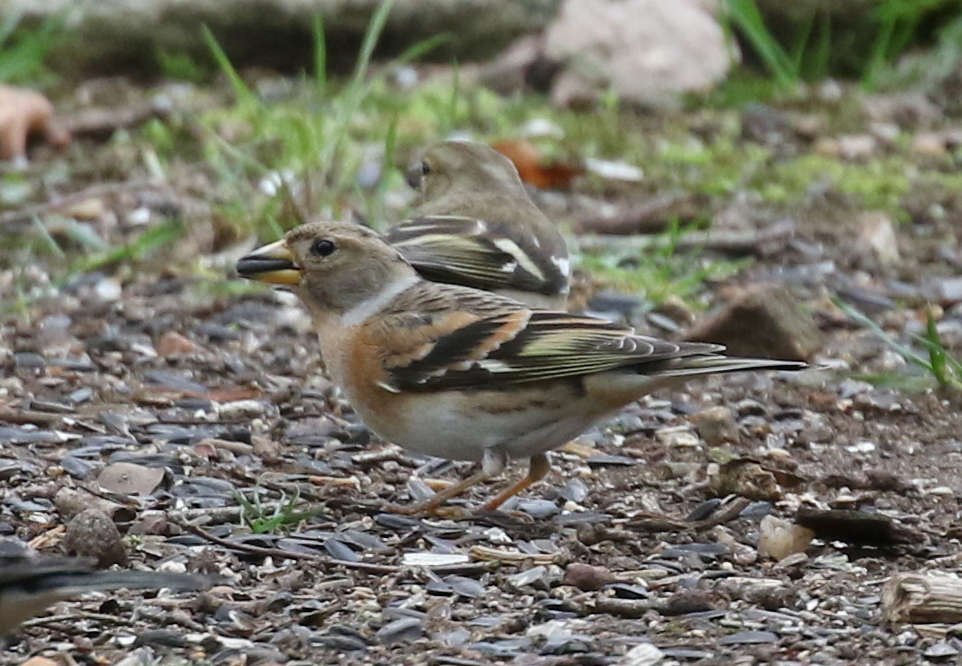
Despite having enjoyed good views of the female Hawfinch from the gate, we still headed down to the paddocks to see if we could see some more. There were at least six more here, including at least four smart males, more richly chestnut coloured than the greyer-brown females. They were all up in the hornbeams when we arrived, so we got the scopes on them and admired their huge, cherry stone-cracking bills.
It was hard to tell exactly how many there were, with some hidden in amongst the tangles of branches and with other birds flying back and forth between the trees. Some of the Hawfinches then flew over to the first hornbeam and dropped down to feed on the ground. We had good views of a male and female feeding together here.
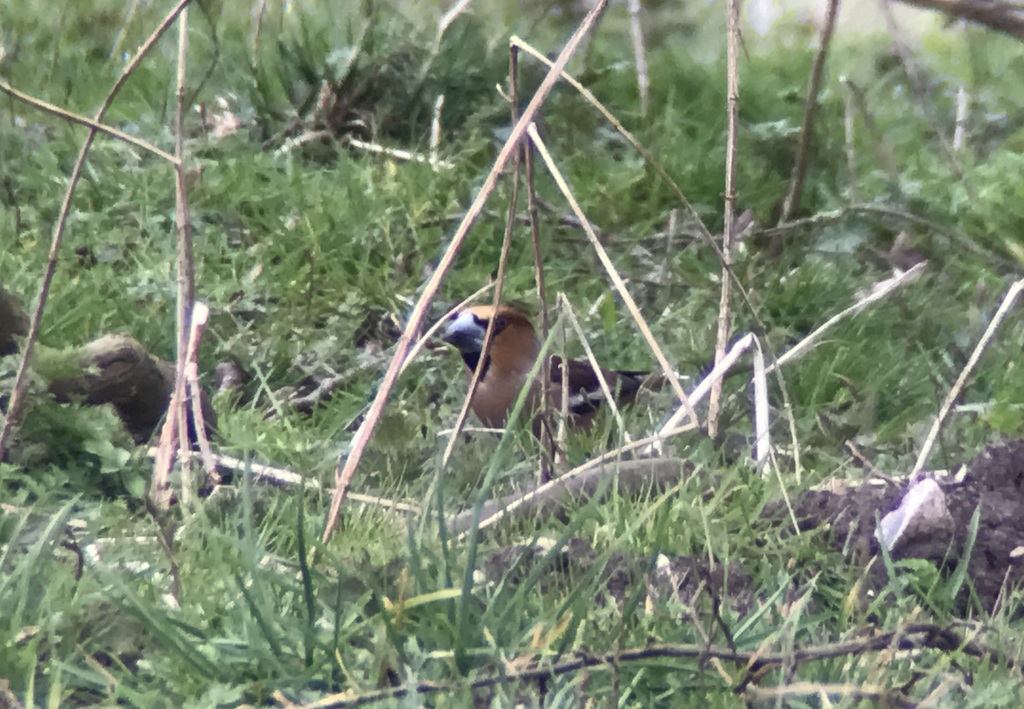
Eventually we had to tear ourselves away from the Hawfinches and we walked back to the bridge. There had been no food put out when we walked down, but we had sprinkled a couple of generous handfuls of sunflower seeds out earlier and there was now a steady procession of birds coming and going.
As well as the ever present Blue Tits and Great Tits, a couple of Long-tailed Tits popped in briefly and a Marsh Tit kept darting in and out. A Nuthatch would have come in too, but some people were standing too close to the pillar and it kept shooting past and not stopping, landing instead in the trees either side. There were several Siskins in the alders here too.

A Little Grebe was laughing madly from the reeds in the lake behind us, so we had a quick walk down beside the water. We couldn’t find the Little Grebe in the reeds but we did find another one diving under the overhanging branches in the middle of the lake. We got the scope on a drake Gadwall to admire the intricacy of the patterns of its feathers.
As we made our way back through the Arboretum, we stopped to look at the Tawny Owl in its usual tree. There was only one here today, and it was well hidden in the branches high in the tree, but after some trial and error we found a good angle where we could get a half decent view of it through the scopes. A Goldcrest was flitting around high in the fir trees above us while we were watching it.
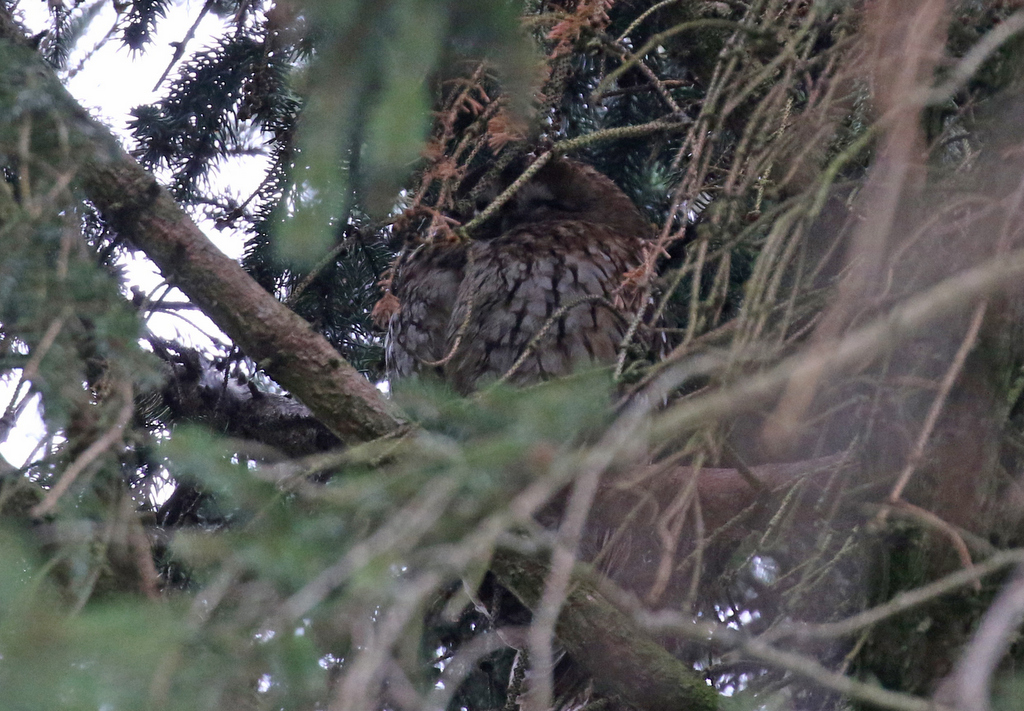
We still had enough time to fit in a quick trip up to Fincham to see if we could see the Great Grey Shrike. There was no one else there when we arrived and no sign of the shrike on the wires, but as we pulled up by a gap in the hedge we scanned across the field beside us and could see it perched in the top of a young oak tree over the far side. We all piled out and had good views of it through the scopes. A scarce winter visitor here from Scandinavia, it may not be too long now before it heads off on its journey back north.
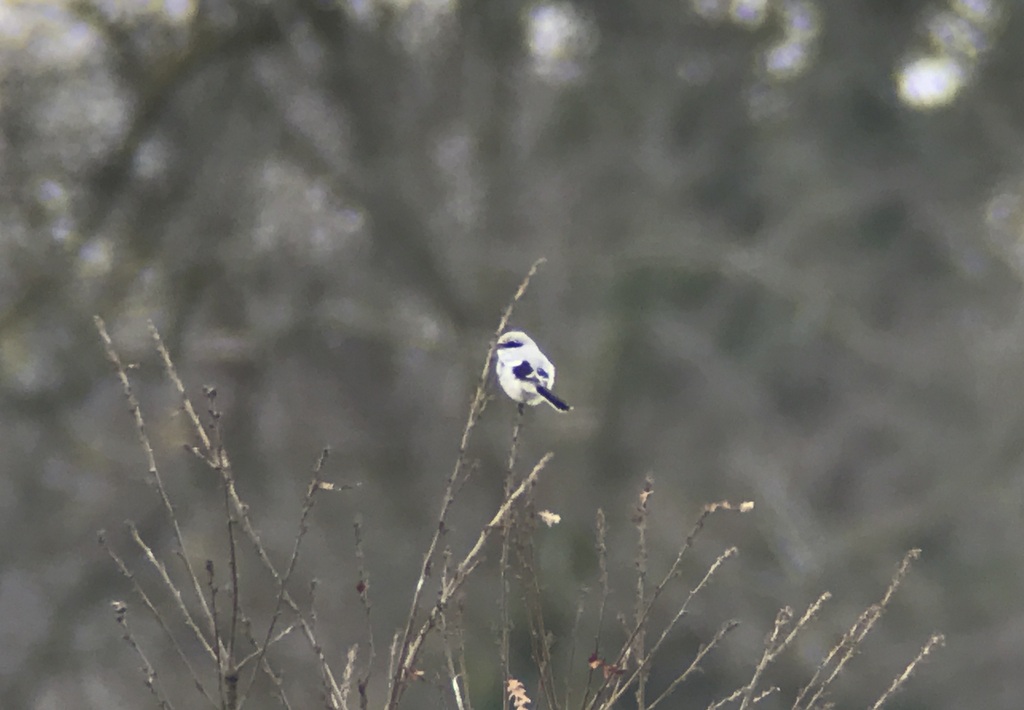
After a while, the Great Grey Shrike flew across to another tree, where we could still just see it through the lower branches of a big oak closer to us. After some last admiring glances, it was time to head back. It was a suitably good bird to wrap up another good day’s birding in the Brecks.
















